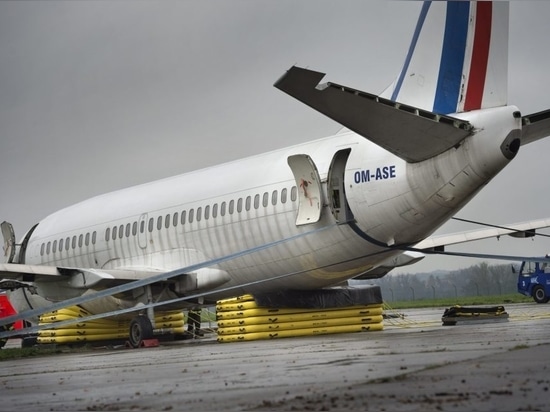
#Industry News
Aircraft Recovery and the Importance of Preparedness for Airports
According to RESQTEC data, approximately 150 incidents per year occur with disabled aircraft across the world. These incidents cause runway and airport closures that, on average, take 17 hours to settle. While the majority of the incidents fall within category I (i.e., light incidents such as a flat tire, landing gear de-bogging, etc.), the average closure time of a runway or airport remains high.
In 2022, at least 143 incidents with disabled aircraft have occurred globally, averaging approximately 3 incidents per week. The longest recovery operation took at least 168 hours (seven days). An overview of the statistics can be found in the RESQTEC Aircraft Recovery Statistics Report 2022.
Aircraft recovery: A shared responsibility
When an incident occurs, it is already too late to begin thinking about aircraft recovery preparedness. Airports cannot afford to wait 24 hours or even a week before a disabled aircraft is removed from the runway. A runway closure this long creates a tremendous financial loss as a consequence. Yet RESQTEC statistics show that preparedness for incidents with disabled aircraft remains low across the globe. Both aircraft and airport operators often lack the required preparation (e.g., disabled aircraft recovery plan), knowledge (e.g., trained and certified staff), and equipment (e.g., aircraft lifting equipment, aircraft moving equipment, support equipment) to perform a quick and safe aircraft recovery operation.
To guarantee efficient airport operations whatever the circumstances, preparedness for aircraft recovery operations is key for any professional airport, especially since very few aircraft operators have the resources and expertise to carry out such operations.
The International Civil Aviation Organization (ICAO) defines the responsibilities for the timely removal of a disabled aircraft in ICAO doc 9137 Airport Service Manual (ASM) Part 5. It states that “responsibilities for the removal of a disabled aircraft lie not only with the aircraft operator but also with the state and the aerodrome operator…” While the aircraft operator always remains in charge of what happens to their aircraft, the actual aircraft recovery operation may be outsourced to the airport operator or other third parties. In most scenarios, this will support the timely removal of the disabled aircraft, especially if the aircraft operator does not have the resources to execute the aircraft recovery operation.
The importance of awareness and preparedness for airport operators
In October 2022, ACI and RESQTEC joined forces to increase awareness among airport professionals of the urgency to prepare for incidents involving disabled aircraft and the aircraft recovery operations that follow. During this webinar, several examples were presented on why preparation is worth the investment for both airports and airlines.
Jean Paul Rios, Aircraft Recovery Manager at Air Canada, presented how he and his team invest in annual training and their relationships with external stakeholders such as their main hub airports in Toronto, Montreal, Vancouver, and Halifax.
Pedro Silva, Head of Fire Services at Lisbon Airport in Portugal, explained how his team’s perseverance to convince the airport management to invest in aircraft recovery preparedness (planning, equipment, and regular training) finally paid off. While no one believed they would ever need, let alone use the equipment, Pedro’s team recovered three disabled aircraft efficiently in 2022.
Juan Manuel Manriquez, Director of Safety at ACI World, stressed that efficient disabled aircraft removal is a shared responsibility, and that communication, coordination, training, and equipment are critical. He was supported by John Olsen, an independent aircraft recovery consultant.
What can you do?
Being prepared will save time and limit the disruption to your operation. The first step in your process of preparation is to ask yourself the following four questions:
> Does your airport have a comprehensive “Disabled Aircraft Removal Plan” and is it up-to-date?
> Does your airport have a designated aircraft recovery team that is fully trained?
> Does your airport have specialized aircraft recovery equipment or does it have arrangements in place to obtain this equipment at short notice?
> Is your airport in regular contact with all relevant stakeholders (e.g., ARFF, airlines, government, fuel companies, handling agents, etc.) and is everyone aware of each other’s capabilities and responsibilities?
The right knowledge and practical experience are crucial for an aircraft recovery operation to go quick and efficient. In my opinion training plays a key role in the preparation process for aircraft recovery teams.
Based on years of experience and strong demand from the market, RESQTEC has developed a comprehensive disabled aircraft recovery training program: the RESQTEC Aircraft Recovery Diploma. By combining the RESQTEC Aircraft Recovery Management Course and the RESQTEC Aircraft Recovery Practical Course, you can now earn a RESQTEC certified diploma in aircraft recovery.
Aircraft recovery operations are never just the responsibility of either an airline or an airport. My message is to talk to each other. Ensure that you communicate, plan, and prepare well in advance to be sure that if an incident occurs everyone knows how to proceed as a team.

